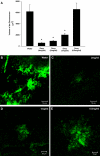Targeting immune privilege to prevent pathogenic neovascularization
- PMID: 20164456
- PMCID: PMC2904009
- DOI: 10.1167/iovs.09-3890
Targeting immune privilege to prevent pathogenic neovascularization
Abstract
PURPOSE. Current studies suggest that the immune system plays a critical role in blinding eye disorders. The eye is an immune-privileged site, and FasL expression is a major part of that mechanism because Fas/FasL interactions regulate inflammation and neovascularization, preventing damage to delicate ocular structures. These studies were undertaken to test the idea that modulating immune privilege might be an effective therapeutic approach to pathogenic angiogenesis in the eye. METHODS. C57BL/6 mice or FasL-defective B6-gld mice were laser treated to induce choroidal neovascularization (CNV). Mice were injected with cytotoxic FasL in the vitreous cavity or were treated with oral doxycycline in the drinking water. They were evaluated for CNV 7 days later. In some experiments eye tissue was harvested and evaluated for FasL expression, macrophage influx by immunohistochemistry, and release of sFasL. RESULTS. Injection of cytotoxic FasL successfully prevented neovascularization in a mouse model of CNV. Oral doxycycline increased functional FasL in the eye and substantially inhibited neovascularization. Doxycycline treatment increased FasL expression on the RPE cells and reduced circulating and tissue-associated sFasL. Treatment was ineffective in B6-gld mice, demonstrating that CNV inhibition was mediated by FasL. CONCLUSIONS. Targeting immune privilege using cytotoxic molecules or by increasing expression of the proapoptotic protein FasL may be a viable approach to treating neovascular eye disease.
Figures





Similar articles
-
Age-dependent changes in FasL (CD95L) modulate macrophage function in a model of age-related macular degeneration.Invest Ophthalmol Vis Sci. 2013 Aug 7;54(8):5321-31. doi: 10.1167/iovs.13-12122. Invest Ophthalmol Vis Sci. 2013. PMID: 23821188 Free PMC article.
-
Overexpression of FasL in retinal pigment epithelial cells reduces choroidal neovascularization.FASEB J. 2006 Aug;20(10):1689-91. doi: 10.1096/fj.05-5653fje. Epub 2006 Jun 28. FASEB J. 2006. PMID: 16807368
-
Doxycycline-mediated inhibition of choroidal neovascularization.Invest Ophthalmol Vis Sci. 2009 Nov;50(11):5098-106. doi: 10.1167/iovs.08-3174. Epub 2009 Jun 10. Invest Ophthalmol Vis Sci. 2009. PMID: 19516001 Free PMC article.
-
Angiogenesis in eye disease: immunity gained or immunity lost?Semin Immunopathol. 2008 Apr;30(2):111-9. doi: 10.1007/s00281-008-0113-8. Epub 2008 Feb 23. Semin Immunopathol. 2008. PMID: 18297288 Review.
-
Role of Fas ligand in ocular tissue.Cornea. 2002 Mar;21(2 Suppl 1):S30-2. doi: 10.1097/00003226-200203001-00007. Cornea. 2002. PMID: 11995807 Review.
Cited by
-
Good news-bad news: the Yin and Yang of immune privilege in the eye.Front Immunol. 2012 Nov 27;3:338. doi: 10.3389/fimmu.2012.00338. eCollection 2012. Front Immunol. 2012. PMID: 23230433 Free PMC article.
-
Cell-Matrix Interactions in the Eye: From Cornea to Choroid.Cells. 2021 Mar 20;10(3):687. doi: 10.3390/cells10030687. Cells. 2021. PMID: 33804633 Free PMC article. Review.
-
Oral Doxycycline Reduces the Total Number of Intraocular Bevacizumab Injections Needed to Control Neovascular Age-related Macular Degeneration.Med Hypothesis Discov Innov Ophthalmol. 2017 Summer;6(2):23-29. Med Hypothesis Discov Innov Ophthalmol. 2017. PMID: 29367931 Free PMC article.
-
Impaired Fas-Fas Ligand Interactions Result in Greater Recurrent Herpetic Stromal Keratitis in Mice.J Immunol Res. 2015;2015:435140. doi: 10.1155/2015/435140. Epub 2015 Oct 4. J Immunol Res. 2015. PMID: 26504854 Free PMC article.
-
Modern Therapeutic Approaches for Noninfectious Ocular Diseases Involving Inflammation.Adv Healthc Mater. 2017 Dec;6(23):10.1002/adhm.201700733. doi: 10.1002/adhm.201700733. Epub 2017 Oct 16. Adv Healthc Mater. 2017. PMID: 29034584 Free PMC article. Review.
References
-
- Niederkorn JY. Immune privilege in the anterior chamber of the eye. Crit Rev Immunol 2002;22:13–46 - PubMed
-
- Griffith TS, Brunner T, Fletcher SM, Green DR, Ferguson TA. Fas ligand-induced apoptosis as a mechanism of immune privilege. Science 1995;270:1189–1192 - PubMed
-
- Lee HO, Herndon JM, Barreiro R, Griffith TS, Ferguson TA. TRAIL: a mechanism of tumor surveillance in an immune privileged site. J Immunol 2002;169:4739–4744 - PubMed
-
- Ferguson TA, Green DR. Fas-ligand and immune privilege: the eyes have it. Cell Death Differ 2001;8:771–772 - PubMed
Publication types
MeSH terms
Substances
Grants and funding
LinkOut - more resources
Full Text Sources
Medical
Molecular Biology Databases
Research Materials
Miscellaneous

